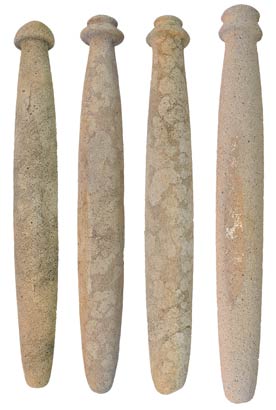Midorikawa Higashi:
Four large-scale stone rods laid in a row are recovered from the center of a
stone-paved feature atop a terrace in the central Tama river basin. What kind
of rite was conducted here?
 Stone-paved feature Nearly circular in shape, with a diameter of 3.2 m east-west and 3.1 m north-south, on the northern side (to the left) is a break in the stone perimeter. If this was a stone-paved dwelling there would be a projection towards the entrance (to the left), but since that area has been greatly disturbed, its existence is not clear. |
 The site from a distance (from the north) The foundation of a storehouse that was under construction remains, and there are disturbances from laying pipes and so forth all over. But even while receiving this much disturbance, the stone-paved feature including the four stone rods (yellow arrow) remained, as if this spot alone was being protected. |

| Map of the distribution of features
The locus of the planned building construction was adjacent to the area of the site, but as it was a vital location nearby a spring on the Tachikawa cliff line, when a test trench and exploratory investigation were conducted a number of stone clusters were found, resulting in the current excavation being carried out. But no one imagined the discovery of a feature this important from the south side of the stone clusters. |
Midorikawa Higashi Site, Kunitachi City, Tokyo Prefecture
A stone-paved feature from the latter part of the Middle to the start of the Late Jōmon
Midorikawa Higashi is a settlement site on the surface of the Aoyagi terrace on the northern bank of the Tama river, in the central portion of its basin in southwest Tokyo prefecture, dating from the latter half of the Earliest into the Late Jōmon periods (approximately 7,000 – 4,000 years ago). Multiple excavations have been conducted up to the present.
In the fourth excavation, in 2012, a stone-paved feature with four large-scale stone rods laid in a row was ascertained, dating from the latter part of the Middle to the start of the Late Jōmon periods.
This stone feature had a floor lined with flat river stones and stones piled in two or three tiers circling the perimeter. No sign was detected whatsoever of either a hearth or scorched earth, however, and judging as well from the scale and structure of the edge, this feature differs from the characteristics of stone-paved dwellings excavated thus far, and accordingly it cannot be called a dwelling.
Unblemished large-scale stone rods are found lined in a row
The stone rods arranged in a row at the center of the feature are all large-scale items 1 m or greater in length. Together with clay figurines, stone rods are objects used in ritual in the Jōmon period, and are nearly always found in a broken or scorched state from those ritual occasions. But the recovery of multiple items intentionally laid in a row and almost without blemish is unparalleled nationwide.
Whether or not this stone-paved feature is one that was used for ritual, and what sort of ritual was conducted within the settlement using these four stone rods, or whether the condition of being placed in a row indicates use in ritual or not, will need investigation in the future.
Regardless, as the stone rodsf arrangement can be considered intentional and strongly tinged with ritual, this is an important discovery that adds a new aspect to rituals involving stone rods as they have been conceived until now. (Shimizu Amane)
(principal artifacts, Midorikawa Higashi Site)

|
Stone rods Latter part of the Middle to the start of the Late Jōmon (approx. 4,000 years ago). Length: 103.6 – 112.5cm; width: 12.95 – 13.9 cm; weight: 22 – 30.8 kg. These were laid out in a row at the center of the stone-paved feature. The tops have a rounded umbrella shape, with subtle differences between them such as either a one- or two-tiered outline. The material is thought to be a type of andesite. The surfaces show tracings of polishing, but there are no signs of being scorched or broken as is often seen on these items from other sites.  Enlarged view of the tops of the stone rods |
